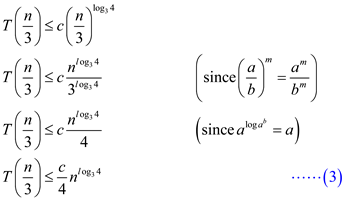Solving Recurrences
The specified recurrence is below:

Guess the solution as  .
.
Use the substitution method to prove that the guess is correct.
So, have to prove that  for a
constant c, where
for a
constant c, where .
.
From the guess,

Using the Substitution Method:
Substitute the guess in the recurrence, then


Finding Boundary Conditions using Mathematical Induction:
Assume that 
For n = 1,
From the specified recurrence,

And from the inequality,

Therefore,  for
for

For n = 2,
From the specified recurrence,

And from the inequality,

Therefore,  for
for

For n = 3,
From the specified recurrence,

And from the inequality,

Therefore,  for
for

Therefore,  ,
,  and
and
 by
choosing the value of c as
by
choosing the value of c as  .
.
Since, the recurrence is true for base case  ,
,  , and
, and
 ;
by the mathematical induction the given recurrence is true for all
values of
;
by the mathematical induction the given recurrence is true for all
values of  .
.
Thus,  .
.
The following steps are used for solving recurrences:
The specified recurrence is as shown below:
• 
Guess the solution as, 
Use Substitution method to prove that the guess is correct.
Prove that  for a
constant c.
for a
constant c.
Here, 
From the guess, the following is ascertained:
• 
The following steps are used to substitute the guess in the recurrence as shown below:

This inequality is not conclusive, still  for a
positive value of c.
for a
positive value of c.
Prove that .
.
Here, d is a constant.


The following steps are used to find the boundary conditions using Mathematical Induction:
The inequality,  does not
work for n = 1 and n = 2 because
does not
work for n = 1 and n = 2 because  cannot be
defined for
cannot be
defined for , since
, since
 and
and 
Assume,  and
and

Calculate, for n = 4 as shown below:
From the specified recurrence, 

From the inequality, the following can be ascertained:

Therefore,  for
for

The following steps are used to calculate for n = 5 as shown below:
From the specified recurrence, 

From the inequality, the following can be ascertained:

Therefore,  for
for

Calculate, for n = 6 as shown below:
From the specified recurrence, 

From the inequality, the following can be ascertained:

Therefore,  for
for

The following steps are used to calculate for n = 7 as shown below:
From the specified recurrence, 

From the inequality, the following can be ascertained:

Therefore,  for
for

The following steps are used to calculate for n = 8 as shown below:
From the specified recurrence, 

From the inequality, the following can be ascertained:

Therefore,  for
for

Therefore, the recurrence is true by the mathematical induction
for the inequality  for all
values of
for all
values of 
 and
and

So, the recurrence is true by the mathematical induction for the
inequality  for all
values of
for all
values of  and
and

Thus,  .
.
Substitution method for solving recurrences
• It is already proved in the text book that the solution of
 is
is
 .
Also , it is known that Big-O gives the asymptotic upper bound.
.
Also , it is known that Big-O gives the asymptotic upper bound.
• Now, it is to be proved that the solution of  is also
is also
 .
.
 provides the asymptotic lower bound.
provides the asymptotic lower bound.
Proving  using Substitution method:
using Substitution method:
• To prove , make a
guess
, make a
guess . Where d is
a positive constant.
. Where d is
a positive constant.
• Now, substitute the  in the
given recursion relation.
in the
given recursion relation.

Finding constants using mathematical induction:
• For base case, prove

• Assume .
.

•  are true for
are true for

• Since , by the
definition of
, by the
definition of  ,
, 
Therefore, the solution of the recurrence relation
 is
is  .
.
Proving that also  :
:
• According to the definition of big- ,
, , if and
only if
, if and
only if  and
and
 for some positive constants
for some positive constants  .
.
• Since it is already proved that  and
and
 for
for ,
,  and
and ,
,
 .
.
Therefore, it can be concluded that the solution of the
recurrence relation  is
is  .
.
Consider the following inductive hypothesis, which is used to
overcome the problem with the boundary condition  for the
given recurrence
for the
given recurrence , without
adjusting the boundary condition.
, without
adjusting the boundary condition.
Now, suppose that . Then, to
overcome the above problem, user has to prove that
. Then, to
overcome the above problem, user has to prove that .
.
Hence, 
Where,  denotes the
floor value.
denotes the
floor value.
Now, simplify the above expression as shown below:



Now, the boundary condition is 
Therefore, from the above calculation, user can select any value
 such that the inductive and base steps are true.
such that the inductive and base steps are true.
Hence, it can be concluded that, .
.
Recurrence Relation of Merge Sort
Consider the following recurrence relation of merge sort:

 Now, prove
that
Now, prove
that 
For a given function g(n),
 , where
there exist constants c1, c2 and
, where
there exist constants c1, c2 and  such
that:
such
that:
 for all
for all 
It means that g(n) is an asymptotically tight bound for f(n) if it can be proved that :
 and
and  .
.
So, the complexity of the merge sort can be proved to be
 if
:
if
:

Let  and
and
 ,
by inductive hypothesis assume true for
,
by inductive hypothesis assume true for 

Hence, .
.
 , by
inductive hypothesis assume true for
, by
inductive hypothesis assume true for 

Hence, and
and


Solving recurrence relation using substitution method:
In the substitution method a solution is gussed every time and checked whether it is working or not.
Consider the following given recurrence relation:

Now, solve the recurrence relation using substitution method, by
making a guess that 
Since substitution method is employing, it is required to prove that

Thus, also
Substitute (3) in (1).

Therefore,
Master method:
Consider the following recurrence relation:

Consider the master theorem for the recurrence equation:

By comparing equation (1) and (2), the value a=4, b=3,
c=1, .
.
Using the master method, simply apply case 1 of the master theorem.
If  for some
constant
for some
constant  then
then


Therefore, .
.
Substitution Method:
Consider the following recurrence relation:

Assume the initial guess as .
.
Then,

Substitute equation (3) in the equation (1)

As
 , the guess
, the guess
 fails.
fails.
Now again guess 

Substitute equation (4) in the equation (1).

As  , the
guess
, the
guess is true.
is true.
Therefore, .
.
Using Master method:
Proof for the solution to the recurrence  is
is  shown below:
shown below:
Consider the following recurrence relation: 
Consider the master theorem for the following recurrence equation:

By comparing equations (1) and (2), the value a=4, b=2, c=2,
and .
.
Using the master method, apply case 1 of the master theorem.
The case 1 of the master theorem is shown below:
If  for some
constant,
for some
constant,  then
then


Therefore, by using the master method the solution for the
given recurrence relation is  .
.
Using Substitution Method:
Proof that the assumption  fails using substitution method is shown below:
fails using substitution method is shown below:
Consider the following recurrence relation:

Solve the recurrence relation by using substitution method.
Assume the initial guess as .
.
Then,

Hence,  fails to be
less than
fails to be
less than  for any
for any
 .
.
Therefore, for the assumed initial guess  , the
obtained solution is
, the
obtained solution is .
.
Hence, the guess  fails by using the substitution method.
fails by using the substitution method.
Now, again make a guess to subtract off a lower-order term to make the substitution proof work.
Solve the recurrence relation by using substitution method.
Then, the guess is  , it means
that the lower term which is subtracted from
, it means
that the lower term which is subtracted from  is
is
 .
.
Then,

Therefore, for the assumed guess  , the
obtained solution,
, the
obtained solution,  is less than
is less than
 .
.
Hence, the guess  is true by
using the substitution method.
is true by
using the substitution method.
Therefore, by using the substitution method
the solution for the given recurrence relation is ,
 .
.
Consider the recurrence relation 
The recurrence is solved by change of variables and for
convenience don’t worry about integral values, such as  to be an
integer. Renaming m = lg n yields
to be an
integer. Renaming m = lg n yields
Let 

Now rename  to produce
the new recurrence
to produce
the new recurrence

Where
Since the value of  in between 1
and 2
in between 1
and 2
Apply case 1 of master theorem then the new recurrence has same solution

Thus, 
Changing back from  then we
obtain
then we
obtain

Thus, the running time 